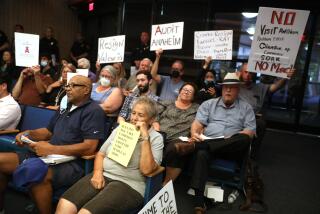To Benefit the Challengers, Alter Public-Funding Goals
- Share via
President Bush has made election reform proposals that would ban corporate, labor and trade association contributions through political action committees. At the same time, the President would reduce the limits for contributions from ideological or issue-related PACs.
The Bush proposals may have merit. But they are also incomplete.
The President followed the traditional approach of restriction and limitation without providing for alternative sources of funds. He wants political party committees to pick up some of the PAC slack, but he offered no incentives for raising more money through the parties--a greater problem for the Democrats than for Republicans.
Some reformers, mostly Democrats, advocate public funding--that is, the use of tax dollars for political campaigns. The logic is that public financing would serve as an acceptable alternative source of needed funds, weaning candidates from a reliance on PACs.
But in all proposals currently being offered, public funding is coupled with limitations on the amounts that candidates and their authorized campaign committees can spend. Spending limits are rightly unacceptable to Republicans, who believe that they will be relegated to permanent minority status in Congress unless able to spend freely in marginal districts and states, or where incumbent Democrats may be vulnerable. Republican determination to stop enactment of expenditure limits is certain, through Senate filibuster or presidential veto, but at least some Republicans are beginning to consider seriously the concept of public funding.
The political rationale for public funding and expenditure limits arises from parallel approaches to a related problem. Incumbents usually attract more money than challengers. The proposed remedy is to limit spending and to provide public funds--thus holding the advantaged down and helping the disadvantaged up. The result, presumably, is to make elections more competitive and also less expensive.
These policies, however, would have a different impact on incumbents and challengers. Because senators and representatives are generally better known, they need less campaign money than challengers. But they are able to raise more funds. The challengers, while they may need more money, have difficulty in getting it. But when they do, either through providing it to their own campaigns out of their own wealth, or by attracting it, they become better known and are more likely to win. Campaign money helps incumbents less per dollar spent than additional dollars spent by challengers.
In short, those votes that change as a result of increased campaign spending generally tend to benefit challengers. Since Republicans have more challengers, they would stand to benefit more than Democrats.
Public subsidies may increase spending for both incumbent and challenger, but work to the benefit of the latter. This would make elections more competitive. On the other hand, any policy that attempts to equalize the financial positions of candidates by limiting campaign spending benefits incumbents, thus lessening electoral competition.
The best solution is to advocate public-funding floors but without spending-limit ceilings. This concept is favored by many of the mature democracies in Western Europe, where government subsidies are given to political parties with no limits on receiving and spending private contributions. The idea is that partial public funding--a floor--would give candidates at least minimal access to the electorate and provide alternative funds so that candidates could reject undesirable private contributions.
Spending ceilings are illusory and, as evidenced by experience in the presidential financing system, are not effective. There is too much leakage based on constitutional rights (independent expenditures), congressional enactments (soft money) and other practices that have developed and found acceptance (bundling).
The “floors without ceilings” concept appears to favor challengers by providing them with money, allowing them minimal access to the electorate. Ensuring that all serious contenders have such access is more important than limiting how much candidates can spend.
Given the fiscal conservatism that characterizes the current political environment, as well as the large federal budget deficits, legislation providing for public funding of congressional campaigns seems self-serving. Many members of Congress are reluctant to vote an appropriation, fearing its unpopularity would be as great as that of members voting themselves a salary increase.
Despite such objections, public funding remains the approach of choice for those who believe that the current system of financing congressional campaigns with private contributions from individuals and groups causes problems that can only be remedied by use of public funds to pay for at least some portion of campaign costs.
In today’s political environment, the notion of “floors without ceilings” merits serious consideration.
More to Read
Get the L.A. Times Politics newsletter
Deeply reported insights into legislation, politics and policy from Sacramento, Washington and beyond. In your inbox three times per week.
You may occasionally receive promotional content from the Los Angeles Times.










